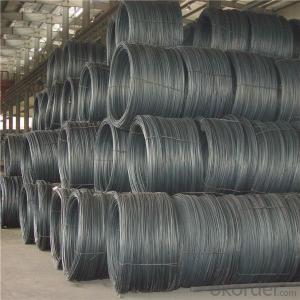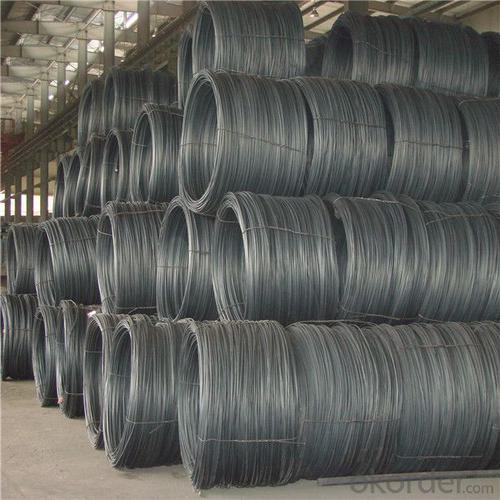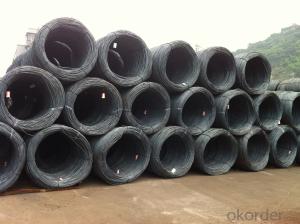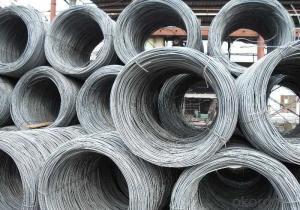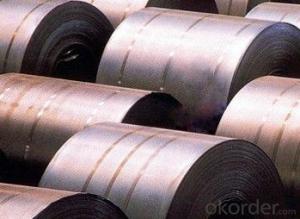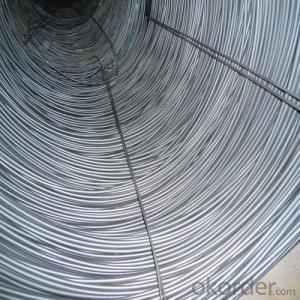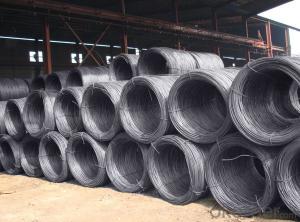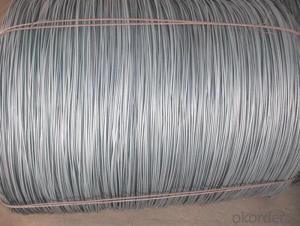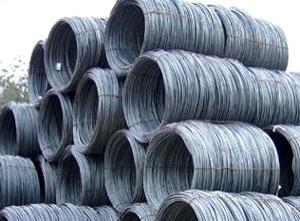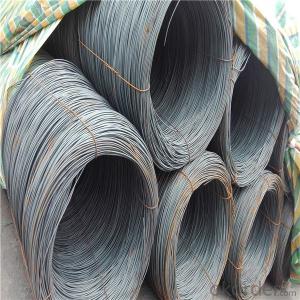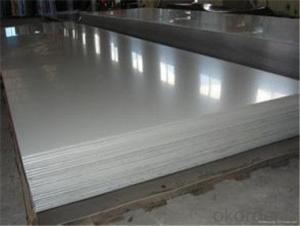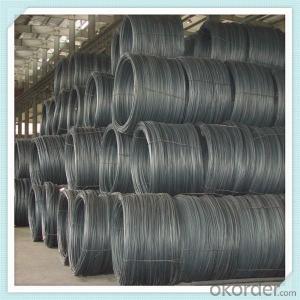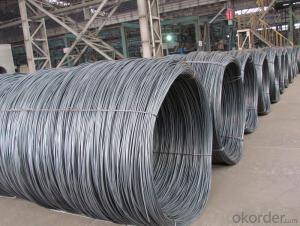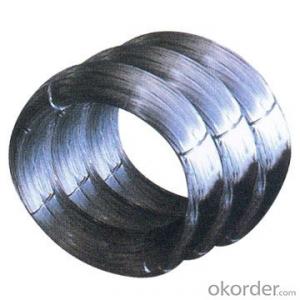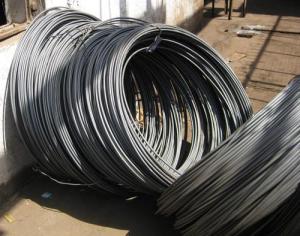Prime alloy steel wire rod different grade
- Loading Port:
- China main port
- Payment Terms:
- TT OR LC
- Min Order Qty:
- 50 m.t.
- Supply Capability:
- 17623 m.t./month
OKorder Service Pledge
OKorder Financial Service
You Might Also Like
Specification
Wire rod is a rolled alloy or nonalloy steel product, produced from a semi (e.g. bloom) and having a round,
rectangular or other cross-section. Particularly fine cross-sections may be achieved by subsequent cold
forming (drawing). Wire rod is wound into coils and transported in this form.
Our service:
(1) We cooperate with famous factories with advanced equipment and well trained workers.
(2) We can provide factory price with trading company service.
(3) We continuously work on the improvement of our processes, guaranteeing
consistently high standards of quality to keep none compensation.
(4) We guarantee 24 hours response and 48 hours solution providing service.
(5) We accept small order quantity before formal cooperation.
(6) We deliver the agreed quality at the agreed time, reacting to changes in
customer wishes in a flexible way.
(7) Due to our volume and selling power, we have excellent freight rates with
shipping lines.
(8) We strive to always be fair and honest in our dealings with customers.
(9) We strive to work together with customers to achieve much more than we can
achieve alone.
(10) Through our passion and commitment we aim to be a market leader in all our
key markets. To maintain our position as market leader we must continue to add
value in all that we do.
Product Description :
Standard | AISI, ASTM, BS, DIN, GB, JIS |
Material/steel grade | Q195-Q235,SAE1006B,SAE1006CR, SAE1008B, SAE1008CR, SAE1010B, SAE1018B, or according to customers requirements |
Wire Gauge | 5.5-12mm |
Coil weight | 1.8-2.1mts |
MOQ | 25MT |
Delivery Time | 15-30 days after receipt of L/C or deposit by T/T |
Packing | In coil and load in container, if large quantity, by bulk vessel; Can be packed as customers' special requirements |
Payment terms | 1).100% irrevocable L/C at sight. 2).30% T/T prepaid and the balance against the copy of B/L. 3).30% T/T prepaid and the balance against L/C |
Application | widely used in machinery parts, manufacturing industry, electronics industry, metal tools and others |
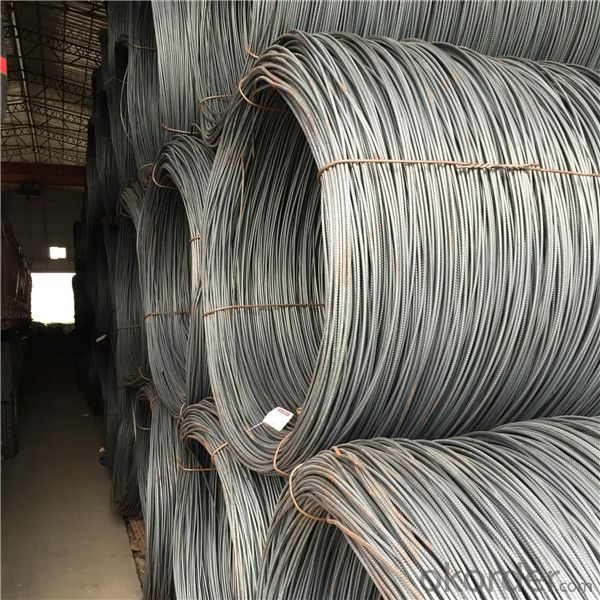
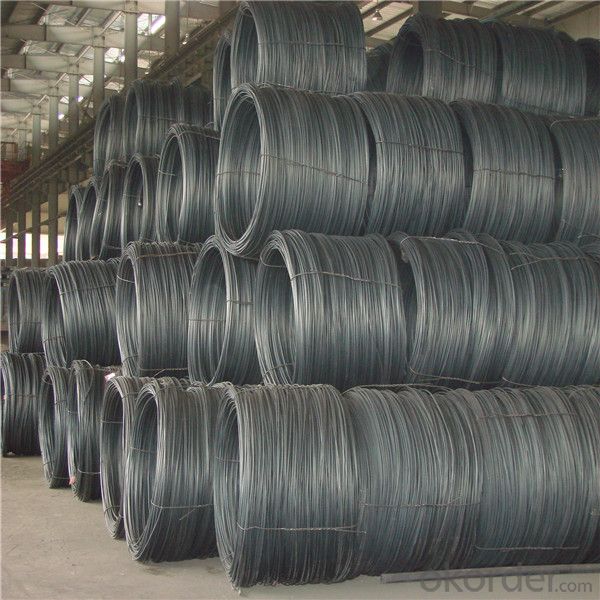
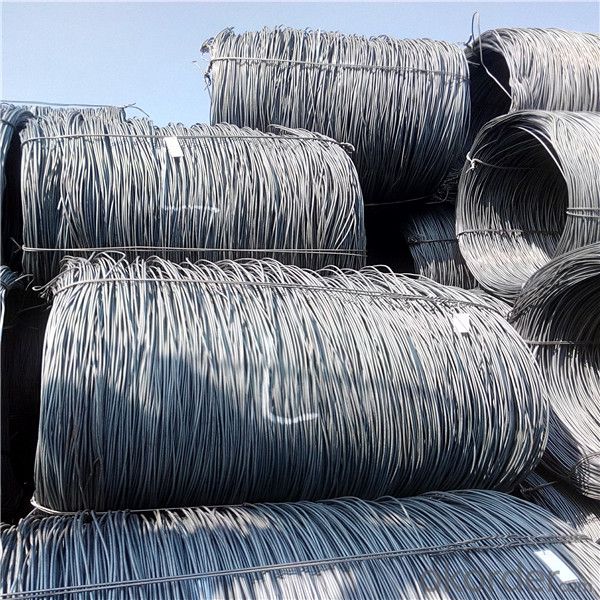
Application :
Mainly used in building and construction as binding wire, tie wire and baling wire; also can be make
for wire mesh.
Packing :
Hot-rolled wire rod is held in a unit with at least four steel straps in the
transverse direction and transported and stored without further packaging.
Before
the steel strapping is applied, the wire rod must be sufficiently compressed.
The strapping is fixed in the transverse direction with a single circumferential
strap so that the strapping does not slip and cause the coil to come apart.
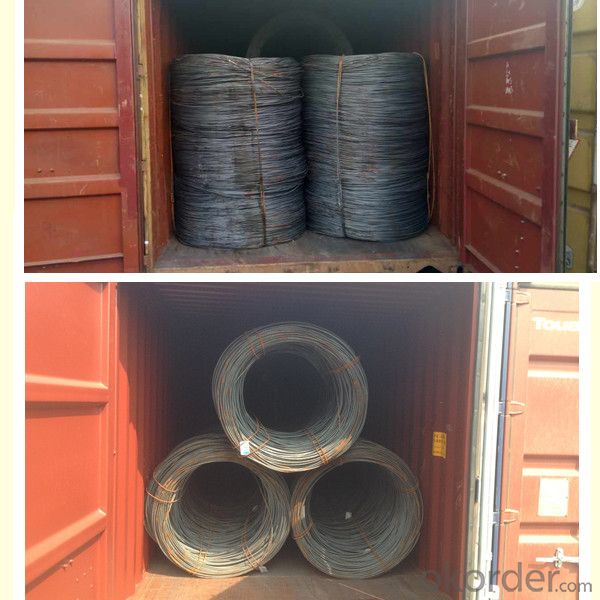
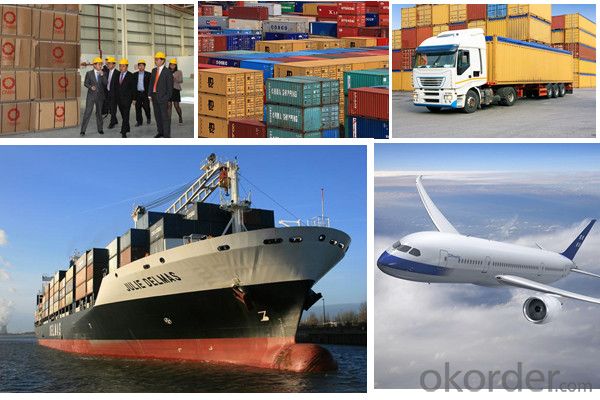
FAQ:
1.Q:Can you accept mixed order?
A: Yes, mixed acceptable .
2. Q: How can I buy CNBM products in my country?
A:Please send us an inquiry or email ,we will reply to you if there is distributor in your country
3. Q: Can we visit your factory?
A: Warmly welcome. Once we have your schedule, we will arrange the
professional sales team to follow up your case.
4. Q: How long does it take to get the product if i place an order?
A:With the process of your requirements,we will pack and deliver in 3
-7 days. If it is by sea shipment,it will take 15-45 days depending on different locations
- Q: What are the common forming techniques used for steel wire rod?
- The common forming techniques used for steel wire rod include drawing, rolling, and extrusion.
- Q: How is steel wire rod inspected for dimensional accuracy?
- Various methods and tools are utilized to inspect the dimensional accuracy of steel wire rod. A common approach involves employing a caliper or micrometer to measure the wire rod's diameter at multiple points along its length. This guarantees that the wire rod meets the necessary diameter specifications. Another crucial aspect of dimensional accuracy pertains to the wire rod's roundness. To evaluate roundness, a roundness tester is employed. This instrument gauges the wire rod's deviation from a perfect circle, ensuring that it remains uniform and devoid of any irregularities. Moreover, the wire rod's straightness is also subject to inspection. This is achieved by placing the wire rod on a surface plate or straight edge and visually examining it for any deviations from a straight line. Any bends or twists in the wire rod can adversely impact its performance and suitability for various applications, underscoring the need to ensure its straightness. The wire rod's surface quality is also scrutinized. This entails visually inspecting the surface for defects such as scratches, pits, or any other irregularities that may compromise its performance or appearance. In sum, the dimensional accuracy of steel wire rod is assessed through a combination of measurement tools, visual inspection, and specialized testing equipment. This comprehensive approach guarantees that the wire rod adheres to the necessary specifications and is fit for its intended purpose.
- Q: What are the major challenges in marketing steel wire rod products?
- There are several major challenges in marketing steel wire rod products. Firstly, the steel industry is highly competitive, and there are numerous suppliers of steel wire rod products in the market. This makes it challenging for companies to differentiate their products and stand out from the competition. Marketing efforts must focus on highlighting the unique features, quality, and value proposition of the steel wire rod products to attract customers. Secondly, the steel industry is heavily influenced by economic factors and global market conditions. Fluctuations in steel prices, changes in demand, and trade policies can significantly impact the market for steel wire rod products. Companies need to closely monitor these factors and adjust their marketing strategies accordingly to remain competitive and profitable. Thirdly, steel wire rod products are often used as raw materials in various industries such as construction, automotive, and manufacturing. This means that the demand for steel wire rod products is closely tied to the performance of these industries. Market fluctuations and changes in these industries can pose challenges in terms of demand forecasting and market positioning for companies marketing steel wire rod products. Additionally, steel wire rod products may require customization or specific certifications to meet the requirements of different industries or projects. This can add complexity to the marketing process as companies need to understand the specific needs and regulations of their target customers and adapt their marketing strategies accordingly. Moreover, environmental concerns and sustainability are gaining more attention in the steel industry. Companies marketing steel wire rod products need to address these concerns by promoting environmentally friendly production processes, sustainable sourcing of raw materials, and recycling initiatives. Failure to address these issues can result in reputational damage and loss of customers. Lastly, building and maintaining strong relationships with customers is crucial in the steel industry. This requires continuous communication, after-sales support, and the ability to provide technical assistance when needed. Developing and maintaining these relationships can be challenging, especially when dealing with large and diverse customer bases. In conclusion, the major challenges in marketing steel wire rod products include intense competition, economic factors, fluctuations in demand, customization requirements, environmental concerns, and the need for strong customer relationships. Overcoming these challenges requires strategic planning, market intelligence, and continuous adaptation to the changing market dynamics.
- Q: How is steel wire rod used in the manufacturing of electrical wires?
- Steel wire rod is a crucial component in the manufacturing of electrical wires as it serves as the raw material for the production process. The wire rod is first drawn through a series of dies to reduce its diameter and increase its length, resulting in a thinner and longer wire. This process, known as wire drawing, helps to enhance the wire's conductivity and flexibility. The steel wire rod is also often coated with a layer of copper or aluminum to further improve its electrical properties. Overall, steel wire rod plays a fundamental role in producing high-quality electrical wires that are widely used in various electrical applications.
- Q: How is the weldability of steel wire rod evaluated?
- The weldability of steel wire rod is evaluated using various techniques and criteria. One of the key factors in assessing weldability is the chemical composition of the steel wire rod. The presence of certain elements, such as carbon, sulfur, and phosphorus, can significantly impact the weldability of the material. Additionally, the mechanical properties of the steel wire rod, such as its tensile strength, ductility, and toughness, are important considerations. These properties can affect the quality and integrity of the weld joint. Another factor to evaluate weldability is the surface condition of the steel wire rod. Any contaminants or impurities on the surface can negatively affect the weldability and lead to defects in the weld. Furthermore, the welding process and parameters used play a crucial role in determining the weldability of steel wire rod. Factors such as heat input, welding speed, and shielding gas selection need to be optimized to ensure proper fusion and minimize the risk of defects. To evaluate the weldability, various tests and inspections are conducted. These include visual examination of the weld for defects like cracks, porosity, or lack of fusion. Non-destructive testing methods like ultrasonic testing or radiography can be used to detect any internal flaws or inconsistencies. Additionally, mechanical tests like tensile and bend testing are performed to evaluate the strength and ductility of the weld joint. These tests help assess the overall quality and performance of the welded steel wire rod. In summary, the weldability of steel wire rod is evaluated by considering factors such as chemical composition, mechanical properties, surface condition, welding process, and conducting tests and inspections to ensure the quality and integrity of the weld joint.
- Q: What are the different types of steel wire rod surface defects and their detection methods?
- During the manufacturing process, various types of defects can occur on the surface of steel wire rods. These defects can have a significant impact on the quality and integrity of the wire rods, so it is crucial to identify and address them before they cause further issues. Here are some common surface defects of steel wire rods and the methods used to detect them: 1. Scale: Oxide layers can form on the surface of wire rods due to exposure to high temperatures during production. Scale can be visually detected by looking for discoloration or by performing a scratch test to see if the scale flakes off easily. 2. Cracks: Surface cracks can be caused by factors like improper cooling, excessive stress, or material defects. Visual inspection is commonly used to detect cracks, but more accurate methods like magnetic particle inspection or ultrasonic testing can also be utilized. 3. Pitting: Pitting refers to small depressions or cavities that form on the surface of wire rods due to corrosion or mechanical damage. Visual inspection is usually sufficient to identify pitting, but techniques like dye penetrant inspection or eddy current testing can be employed for a more detailed examination. 4. Surface roughness: Irregular or uneven texture on the surface of wire rods is known as surface roughness. It can be a result of improper manufacturing processes or inadequate quality control. Visual inspection or the use of a profilometer to measure roughness quantitatively can help detect surface roughness. 5. Inclusions: Non-metallic substances, such as slag, dirt, or oxide particles, can become embedded in the surface of wire rods, causing weak spots or affecting mechanical properties. Visual inspection can identify large inclusions, while microscopic examination or techniques like X-ray inspection can detect smaller or subsurface inclusions. 6. Coating defects: If a wire rod has a coating, defects like peeling, blistering, or uneven thickness can occur. Visual inspection is generally sufficient, but techniques like ultrasonic testing or electrical conductivity measurements can provide a more comprehensive assessment. It is important to note that while visual inspection is commonly used, more advanced non-destructive testing (NDT) methods can offer more accurate and reliable detection of surface defects. By employing a combination of these methods, the identification and rectification of surface defects in steel wire rods can be ensured, ultimately enhancing their quality and performance.
- Q: What are the safety requirements for steel wire rod used in elevator wire ropes?
- The safety requirements for steel wire rod used in elevator wire ropes are crucial to ensure the reliable and secure operation of elevators. These requirements are set by various industry standards and regulations to guarantee the strength, durability, and performance of the wire ropes. Some of the key safety requirements for steel wire rod in elevator wire ropes include: 1. Material Quality: The steel wire rod used in elevator wire ropes must meet specific material standards, typically specified by organizations such as the American Society for Testing and Materials (ASTM). These standards define the chemical composition, mechanical properties, and other characteristics of the steel to ensure it can withstand the required loads and stresses. 2. Strength: Elevator wire ropes are subject to significant loads and stresses during operation. Therefore, the steel wire rod used must have a high tensile strength to withstand these forces without breaking. The minimum tensile strength requirements are typically defined by industry standards to ensure the safety of passengers and the elevator system. 3. Fatigue Resistance: Elevator wire ropes undergo repeated bending and flexing during operation, which can cause fatigue failure if the steel wire rod is not designed to resist this. The steel wire rod should have excellent fatigue resistance properties, enabling the wire rope to withstand millions of cycles without degradation. 4. Surface Quality: The surface of the steel wire rod must be smooth and free from any defects or imperfections that could weaken the wire rope. Surface irregularities, such as pits, scratches, or deformations, can act as stress concentration points and reduce the overall strength and safety of the wire rope. 5. Dimensional Accuracy: To ensure proper fit and functionality, the steel wire rod used in elevator wire ropes must meet specific dimensional tolerances. These tolerances include diameter, roundness, and straightness, which are crucial for proper assembly and operation of the wire ropes. 6. Testing and Certification: Manufacturers of steel wire rod used in elevator wire ropes should conduct rigorous testing to verify compliance with safety requirements. These tests may include tensile strength testing, fatigue testing, surface inspection, and dimensional measurements. Certification from recognized bodies or compliance with industry standards, such as ISO 9001, further ensures the quality and safety of the steel wire rod. By adhering to these safety requirements, elevator manufacturers and operators can be confident in the reliability and performance of their wire ropes, ultimately ensuring the safety of passengers and the smooth functioning of elevator systems.
- Q: What is the pricing structure of steel wire rod?
- The pricing structure of steel wire rod varies based on several factors such as the quality of the steel, market demand, production costs, and global economic conditions. It is typically determined by market forces and can fluctuate over time.
- Q: What are the different types of steel wire rod coatings used for enhanced wear resistance?
- There are several different types of steel wire rod coatings that are commonly used to enhance wear resistance. These coatings are applied to the surface of the steel wire rod to provide a protective layer that improves the longevity and durability of the wire. One type of coating used for enhanced wear resistance is zinc. Zinc coating, also known as galvanizing, involves immersing the steel wire rod in a bath of molten zinc. This process creates a layer of zinc on the surface of the wire, which acts as a barrier against corrosion and wear. Zinc coatings are commonly used in applications where the wire will be exposed to harsh environments or high levels of moisture. Another type of coating used for wear resistance is polymer. Polymer coatings are typically applied as a thin layer on the surface of the steel wire rod. These coatings provide a protective barrier against abrasion, chemicals, and other forms of wear. Polymer coatings can be customized to provide specific properties such as high temperature resistance, low friction, or resistance to specific chemicals, making them suitable for a wide range of applications. Additionally, ceramic coatings are also used to enhance wear resistance in steel wire rods. Ceramic coatings are typically applied using a chemical or physical vapor deposition process. These coatings create a thin layer of ceramic material on the surface of the wire rod, which offers excellent resistance to wear, corrosion, and high temperatures. Ceramic coatings are commonly used in applications where the wire will be subjected to extreme conditions or high levels of friction. In conclusion, there are various types of steel wire rod coatings used to enhance wear resistance. Zinc coatings provide corrosion protection, polymer coatings offer resistance to abrasion and chemicals, and ceramic coatings provide excellent resistance to wear, corrosion, and high temperatures. The choice of coating depends on the specific application and the desired level of wear resistance required.
- Q: How is steel wire rod stored and protected from corrosion?
- Steel wire rods are typically stored in dry and well-ventilated areas to prevent moisture accumulation, as moisture can accelerate corrosion. They are often kept in stacks or on racks with adequate spacing between each rod to allow for air circulation. Additionally, steel wire rods are protected from corrosion by applying a coating or using corrosion-resistant materials such as galvanized or stainless steel. Regular inspections and maintenance are conducted to ensure the storage conditions are optimal and any signs of corrosion are promptly addressed.
Send your message to us
Prime alloy steel wire rod different grade
- Loading Port:
- China main port
- Payment Terms:
- TT OR LC
- Min Order Qty:
- 50 m.t.
- Supply Capability:
- 17623 m.t./month
OKorder Service Pledge
OKorder Financial Service
Similar products
Hot products
Hot Searches
Related keywords
